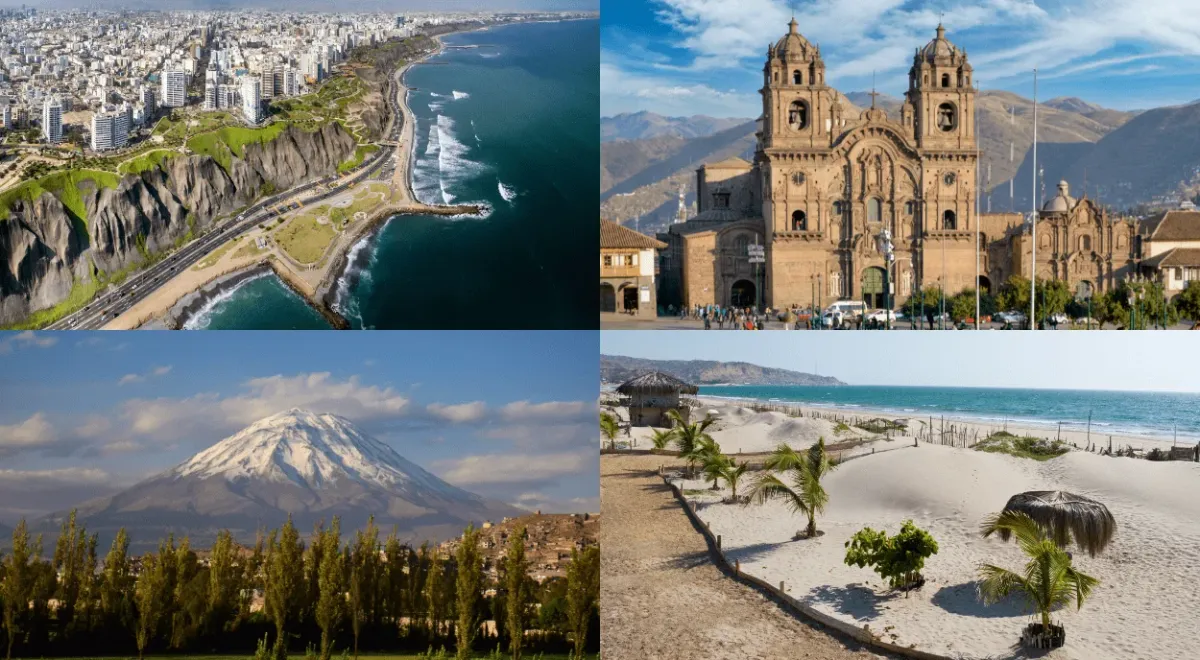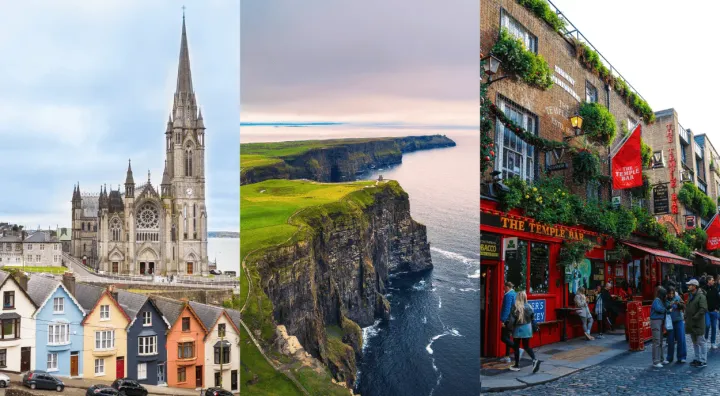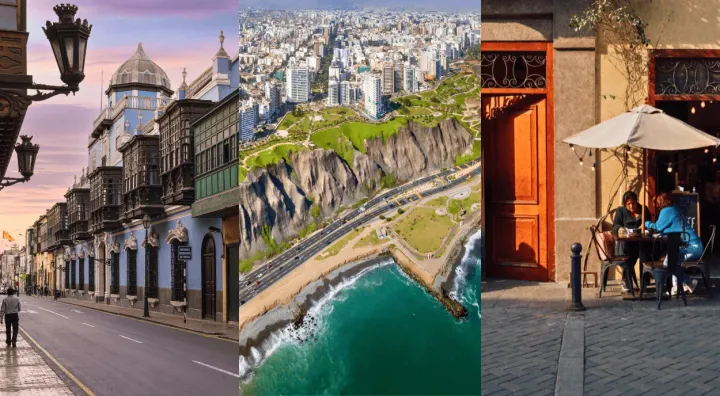Best Places in Peru for Digital Nomads

Before landing in Peru, I honestly wasn’t sure what to expect. I knew about Machu Picchu, obviously, and I’d heard Lima had great food... But I didn’t imagine I’d end up loving it this much as a digital nomad.
Peru is diverse in every possible way: landscapes, culture, climate, and pace of life. And while the digital nomad “scene” is still growing here, I still found some amazing spots that tick all the boxes: reliable Wi-Fi, affordable living, and just enough adventure to make the workdays feel a little less work-y.
So if you’re considering Peru as your next remote base, here are five places I loved, and think you might too.
What Makes Peru Ideal for Digital Nomads?
Peru is one of those places that feels made for digital nomads. There are cosmopolitan cities, laid-back beach towns, and the magic of the Andes all in one country.
First off, the internet is very reliable. So, if you’re worried about your next Zoom call dropping mid-sentence, don’t be. Connectivity in most major cities has improved a lot over the past few years. Places like Lima, Arequipa, and Cusco now offer strong Wi-Fi in cafes, coworking spaces, and colivings. And if the Wi-Fi isn’t perfect where you’re staying, eSIMs or local SIM cards work well as a backup.
Then there’s the food. Peru didn’t win “World’s Leading Culinary Destination 2024” for nothing. Fresh ceviche, lomo saltado, hearty Andean soups like chupe de camarones, and sweet picarones for dessert... You’re definitely not going hungry here. Oh, and don’t forget the pisco. Always say yes to the pisco!
Cost-wise, it’s a great choice if you’re trying to keep your expenses in check. Outside of Lima’s upscale neighborhoods, you can live comfortably for much less than you’d spend in the U.S. or Europe, often under $1,500/month, depending on your lifestyle. Local food, transportation, and rent are all very affordable.
Now for the big question: can you stay long-term? In late 2023, the Peruvian government announced a new digital nomad visa that would let remote workers stay in the country for up to a year. It’s a promising step, but here’s the catch: it hasn’t been fully rolled out yet. So for now, most nomads stick with the standard 90-day tourist visa, which works fine for shorter stays (and is often extendable).
1. Lima
Lima is often the first stop for anyone arriving in Peru, and honestly, it should be. It’s one of the best cities in South America and the most developed city in the country in terms of infrastructure, coworking culture, amenities, and international connections.
You’ll likely land at Jorge Chávez International Airport (LIM), about 20–30 minutes from the coast. For your base, stick to neighborhoods like Miraflores, Barranco, or San Isidro. They’re safe, walkable, and full of cafés, coworking spots, and ocean views.
Digital Nomad Scene
Lima's coworking scene is alive and vibrant. Spaces like Regus, Co-Labora, WORX, and Liberal offer flexible plans, including hot desks and 24/7 access. Even WeWork has a presence here.
If you'd rather work from a cafe, Lima doesn’t disappoint either. Miraflores and Barranco are packed with laptop-friendly spots like Puku Puku, Tostaduría Bisetti, and La Bodega Verde.
Cost of Living
Lima is the most expensive city in Peru, but compared to North America or Europe, it’s still very affordable. A one-bedroom near the coast or in a good neighborhood can go for USD $500–$800, depending on the area and how modern the building is.
Utilities, groceries, local transport, and occasional splurges can bring a comfortable digital nomad budget to $1,300–$1,500/month in many cases.
Keep in mind: in neighborhoods further from the coast or downtown, prices drop. But amenities, safety, and access may also diminish.
Internet & Connectivity
Lima has the fastest internet in Peru, and in most modern buildings and coworking spaces, you can expect speeds of 100–150 Mbps down and 50–70 Mbps up.
Apartments in newer buildings often come with fiber connections. That said, always check your Airbnb reviews since older buildings or farther-out neighborhoods can still be hit or miss when it comes to stability and speed.
2. Cusco
Sitting at 3,400 meters in the Andes, Cusco is one of the most visited places in Peru as the gateway to Machu Picchu, the Sacred Valley, and Vinicunca (Rainbow Mountain).
But beyond the tourists and Incan ruins, Cusco also makes for a pretty unique base as a remote worker, especially if you’re craving a bit of that mystical mountain energy in your work-life routine.
Digital Nomad Scene
There are a handful of coworking spaces around town like Ayni, Coworking Cusco, and Kuska that offer solid internet and a quiet place to get things done. If you’re staying at Pariwana Hostel, they have a coworking area that’s great for getting work done in a more social, backpacker-style environment.
You’ll also find plenty of laptop-friendly cafés. Black Llama Coffee is my personal favorite, and most spots in the historic center are happy to have you camp out for a few hours (just grab a coffee or snack to keep things friendly).
Cost of Living
Cusco is definitely more affordable than Lima, but keep in mind it’s still a tourist hub, so prices can fluctuate depending on the season.
You can find a decent apartment in the city center for around $500/month, and even less if you’re okay with something more basic. A local lunch menu will only set you back $3–4, while dinner at a nicer restaurant might be around $15–20.
Many nomads get by comfortably on around $1,100/month, though if you’re staying long-term and cooking at home, you can do it for less.
Internet & Connectivity
Wi-Fi in Cusco is a bit of a mixed bag. You’ll usually be fine for most remote work, but speeds can vary a lot depending on where you’re staying, so I do recommend working from a coworking space or cafe with strong WiFi.
Callout: You’ll fly into Alejandro Velasco Astete Airport, which has frequent flights to and from Lima. Once you land, take it easy because the altitude is no joke, especially if it’s your first time at this elevation. Your new best friend will be mate de coca (coca tea), which you’ll find pretty much everywhere.
3. Piura (and the North Coast)
If what you really want is sun, sea, and surf, then head north to Piura and its relaxed beach towns like Máncora, Vichayito, or Los Órganos. This is the kind of place where time slows down: flip-flops all day, ceviche for lunch, and golden hour yoga with your laptop packed away.
You’ll fly into Piura Airport, then take a bus or shared colectivo to the coast. It takes a bit to get there, but once you arrive, the whole place just slows down.
Digital Nomad Scene
In Máncora, you’ll find a few coworking spaces like Biosfera and some cafés that are remote-work friendly. The vibe is casual and unplugged, and it’s more about balancing light work with a lot of beach time.
If you need reliable internet for calls or uploads, stick to town centers or proper coworking spots. Internet isn’t as fast or stable as Lima or Cusco, but it’s totally fine for emails, writing, admin tasks, and even most video calls (just… maybe don’t schedule five back-to-back).
Cost of Living
One of the perks of the north is that it’s still super affordable. A cozy bungalow or small apartment near the beach, for example, can cost around $400–600/month.
Fresh seafood is everywhere, and you can get a solid meal for $6–8, or hit the local market for even cheaper groceries.
Surfboard rentals with a lesson start at $20, and once you settle into a rhythm, it’s easy to live well for $1,000/month or less.
Internet & Connectivity
In Piura city, speeds are more stable (30–50 Mbps on average), while in smaller towns like Máncora or Vichayito, it can vary a lot depending on where you’re staying. Some places are great, others… not so much.
My best tip is Always ask for a speed test screenshot before booking an Airbnb, and have a local SIM or eSIM as a backup if your work can’t wait. Coworking spaces usually have the best connections, so they’re worth checking out if you're staying a while.
4. Arequipa
Arequipa is Peru’s second-largest city and a seriously underrated spot for digital nomads. It’s got a beautiful mix of colonial architecture, modern comforts, and a much slower, sunnier pace of life compared to Lima. They call it the “White City” thanks to its buildings made from white volcanic stone, and on a clear day, with volcanoes in the background, it’s kind of unreal.
Digital Nomad Scene
You’ve got options here. Coworking spaces like Conexa and Prime are reliable, with good setups and affordable monthly rates. If you're more of a café person, there are tons of great spots around the Plaza de Armas where you can grab a latte and knock out a few hours of deep work. Locals are pretty used to remote workers, so no weird looks if you open your laptop.
Cost of Living
Arequipa is still super affordable, especially for a city this size. You can find a nice apartment in the center for around $500–600/month, especially if you’re staying a few weeks or more.
Groceries won’t cost much, around $100–150/month if you’re cooking at home. All in, you’re looking at around $1,200/month for a comfortable lifestyle, and less if you’re keeping things simple.
Internet & Connectivity
Internet is usually reliable. Most apartments and coworking spaces offer speeds around 50–80 Mbps, which is totally fine for video calls, big uploads, and full workdays. That said, if you’re staying somewhere older or further out, it’s still smart to ask for a speed test before booking as not everything is fiber-connected yet.
5. Tarapoto
Tarapoto is tucked away in the northern jungle of Peru and surrounded by waterfalls, rivers, and some of the wildest nature you’ll find without going completely off-grid. It’s not a digital nomad hotspot yet, and that’s kind of the beauty of it.
There’s not much nightlife, but if you love the outdoors, you won’t get bored. Spend your mornings working, then your afternoons hiking, swimming in Laguna Azul, or exploring jungle trails. And yes, get health insurance that covers jungle activities. You’ll thank yourself later.
Digital Nomad Scene
Tarapoto’s not packed with coworking spaces (yet), but you’ll find places that get it. Casa Bosque is one of the better-known options with coworking setups and surprisingly good Wi-Fi for where you are.
Some hotels and Airbnbs are starting to advertise remote work setups or even Starlink, but it’s still early days. If you need to work regularly, make sure you ask for a speed test screenshot before booking.
Cost of Living
Easily one of the cheapest places on this list. You can rent a small apartment or jungle bungalow for around $400/month. Local food is cheap and delicious, and lunch menus go for $2–3, and fresh tropical fruit is everywhere. If you’re keeping things simple, you can live here for $900/month or less without sacrificing much
Just be ready for a more low-key lifestyle: fewer Western comforts, but a whole lot more nature.
Internet & Connectivity
The internet won’t be Lima-level fast. In town, it’s usually solid enough for emails, calls, and general day-to-day work.
Some places now have Starlink, which makes a big difference, but don’t assume you’ll have it. Always check with your host first and have an eSIM or local SIM as a backup, just in case.
Are You Ready to Explore Peru as a Digital Nomad?

Join our global
digital nomad community
Join us for free
Freaking Nomads is supported by you. Clicking through our links may earn us a small affiliate commission, and that's what allows us to keep producing free, helpful content. Learn more




 Travel tips, hacks, and news
Travel tips, hacks, and news Exclusive travel discounts
Exclusive travel discounts Offers and promotions
Offers and promotions Digital nomad inspiration
Digital nomad inspiration Latest articles form our blog
Latest articles form our blog